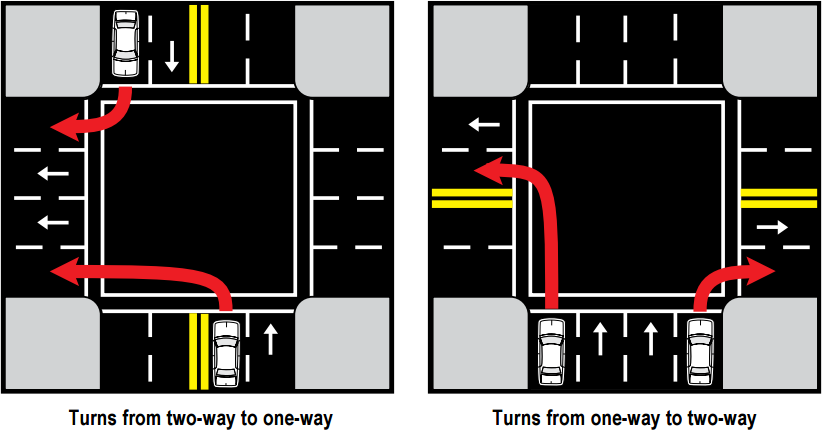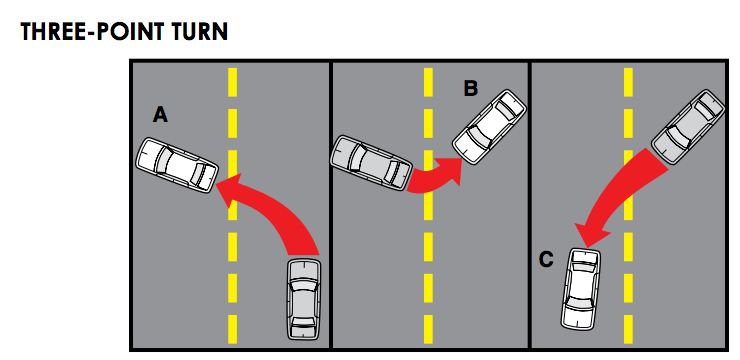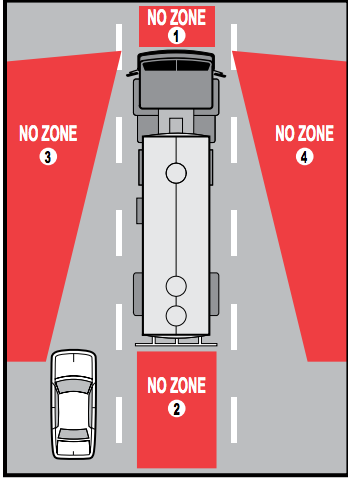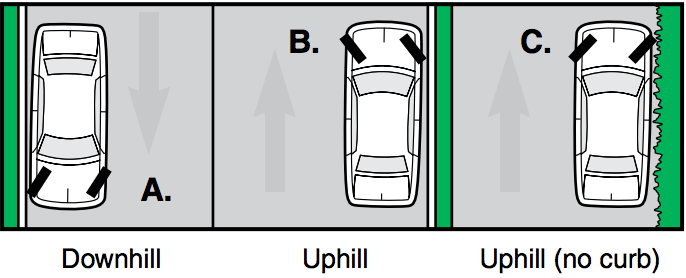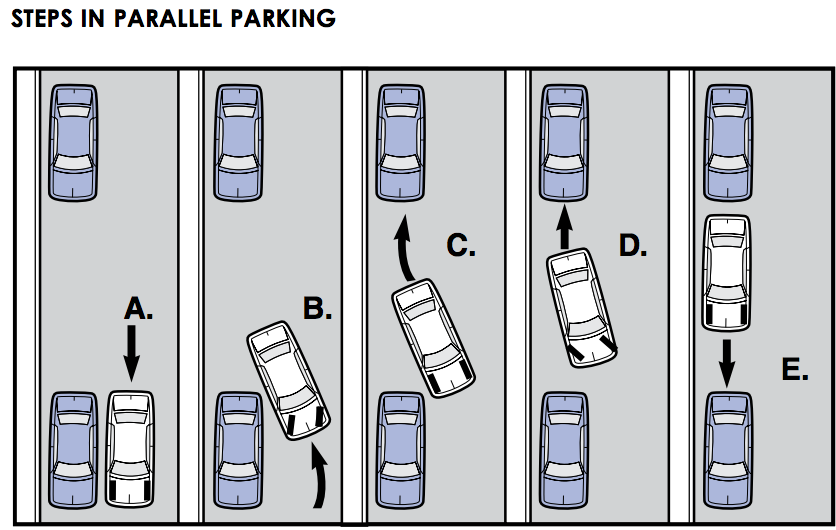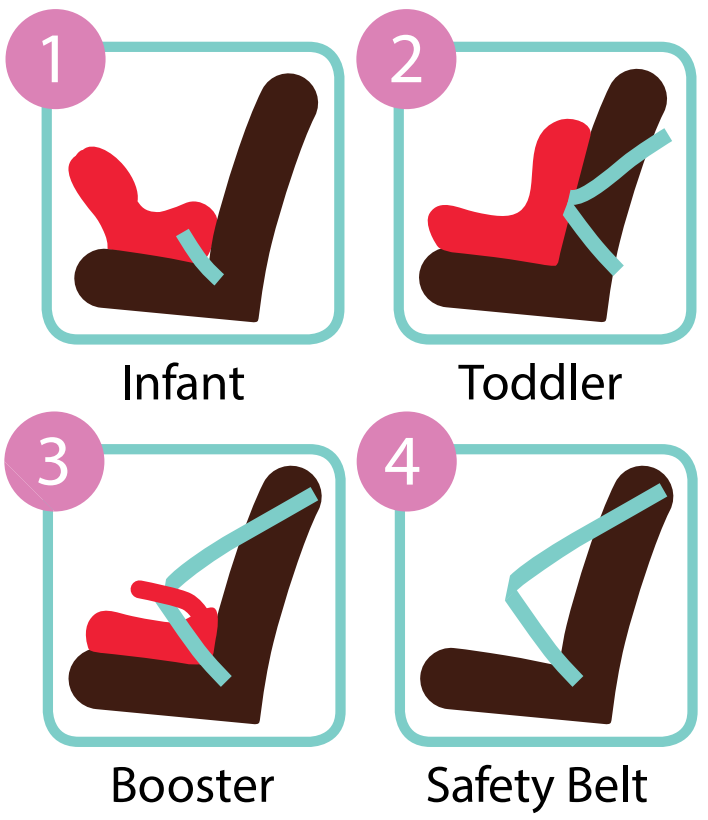Driving a motor vehicle is a serious responsibility, not only to you, but also to all others on the road. To be a good, safe driver you must know the rules and respect them, know and follow proper driving procedures, and have a good = attitude. The proper attitude toward the laws and toward others on the road is extremely important. Courtesy toward others should be practiced at all times.
GOOD DRIVING HABITS
It is just as easy to develop good driving habits as it is to fall into bad habits. Safety techniques begin the moment you step into the car. Start by forming good habits immediately and use them for EVERY trip, whether it’s for just a few blocks or for several hundred miles.
ENTERING THE CAR
Develop a routine for entering and leaving your car. Adjust the seat, mirrors, and check passengers to be sure they are properly seated and do not interfere with your driving. Before switching on the ignition, buckle your safety belt and see that all passengers do likewise. If you are driving a hand-shift vehicle equipped with a manual transmission, push in the clutch before turning the ignition key. If you have an automatic transmission, be sure the indicator is in park or neutral and depress the brake pedal as you turn the key.
POSTURE AND STEERING
Good posture at the steering wheel is important. It will result in better vision, control, and ability to maneuver in an emergency. You should sit erect, comfortably gripping the outside rim of the steering wheel with both hands. Don’t grip the wheel so tightly as to restrict reflexes but keep a firm grip to maintain control. Always keep both hands on the wheel except when it is necessary to remove one for signaling or for another purpose necessary to the operation of the vehicle.
STARTING FROM A PARKING PLACE
In preparing to leave a parallel parking spot, look over your shoulder as well as in rear view mirrors and wait until the way is clear before pulling into traffic. Indicate your intention by signaling. Enter traffic in the nearest lane and remain in that lane until it is safe to change into another lane.
ON THE ROAD
You must drive within a single traffic lane without weaving from one lane to another or straddling the lane marking. You are in a traffic lane whenever driving on any street or highway. A traffic lane is part of a street or highway wide
enough to permit safe operation of a vehicle or line of vehicles. Often lanes are
not marked, but they are there whether marked or not.
RULES FOR TURNS
These are some of the rules for making safe, courteous and legal turns:
- Prepare for the turn before you get there. Don’t make the decision to
turn at the last moment. Observe and be alert. - Get into the proper turn lane well ahead of the place where you will
make your turn. Be sure it is safe to make the change. - At least 100 feet before making the turn, signal your intentions.
- Continue the signal until you are ready to make the actual turn. Signals are given to inform both pedestrians and drivers of your intentions.
- Both hands should be on the steering wheel when actually turning. Pedestrians have the right of way over the motor vehicle.
- Reduce speed before making turns.
- Always finish your turn in the proper lane.
- Make sure in advance that it is safe to turn. Check to the front, rear, and sides for cars and pedestrians, and also watch for situations developing in the street you will enter upon turning.
- Be certain your signals are discontinued after completing a maneuver.
- During the daytime, hand and arm signals may be used in addition to signal lights. Reflection of bright sunlight may make it difficult for other motorists to see your flashing signal light.
TURNING FROM FOUR-LANE HIGHWAYS
In making a right turn from a four-lane or divided highway, enter the right lane well in advance of the turn and make a tight turn into the right lane of the cross street.
For a left turn, move to the lane nearest the center line or traffic divider and turn from the inside lane. Avoid a wide swing during your turn. Enter the cross street just to the right of the centerline. Some intersections are marked to permit turns from more than one lane and you may make your turns as indicated by signs or pavement markings.
PROPER TURNING RULES
- Plan ahead.
- Be in the proper lane well before the turn (follow proper steps to change lanes).
- Signal the direction you plan to turn.
- Reduce your speed and check for persons and vehicles in your turning path.
- Turn into the proper lane (see Turning Diagrams).
- Adjust speed to the flow of traffic.
When making a three-point-turn, turning your vehicle around so that you are driving in the opposite direction from the direction that you were traveling, the three-point-turn must be made without endangering other traffic. They are normally permitted where your vehicle can be seen for a great distance and where traffic is such that making a three-point-turn would not constitute a hazard. Three-point turns are not permitted on interstate freeways, on curves, or near the top of hills where you cannot be seen by drivers of other vehicles approaching from either direction within 500 feet.
Three-point turns are governed by local ordinances and there may be no signs to warn you. Prohibitory signs are usually posted at hazardous locations.
CURVES
Slow down before entering curves because of the danger of running over the center line or leaving the roadway. A driver should enter a curve slow enough to enable him to accelerate slightly when actually rounding the curve.
SHARING THE ROAD WITH MOTORCYCLES
The increasing popularity of motorcycle riding is evident by the variety of riders and two-wheeled motor vehicles appearing on our streets and highways. Motorcycle accident statistics show that a substantial percentage of the accidents involve riders with limited experience.
Motorcyclists have the same rights and responsibilities on public roadways as other highway users. While legally everyone must abide by the same traffic laws, there are special situations and conditions drivers need to be aware of so they can share the road safely with those who choose to use two wheels instead of four.
Why is it so important to be aware of motorcycles and their operation? Primarily because motorcycles are not easily identified in traffic. Motorcycles are only about two feet wide compared with the five-to-six-foot width of an automobile. Even when seen, it’s difficult for some drivers to judge how far away motorcyclists are.
Finally, even when seen and the distance away is correctly judged, some drivers can’t tell how fast motorcyclists are traveling. Being alert to this special perceptual problem and how motorcyclists react in specific situations can help to avoid colliding with motorcyclists in traffic. The following are a few of the specific situations that call for special attention by motorcyclists and the driver.
Left turns in front of an oncoming motorcyclist account for a large percentage of car/cycle injury producing accidents. The problem of not seeing the motorcyclist is two fold: car drivers may fail to pick the cyclist out of the traffic scene, or drivers may fail to judge the speed of the oncoming motorcycle. The correct behavior is to:
LOOK AND LOOK AGAIN. MAKE SURE YOU KNOW THE SPEED OF THE MOTORCYCLE BEFORE MAKING A LEFT TURN.
Turn signals are not automatically self-canceling on most motorcycles. At times, the rider may forget to turn the signal off. Before making a turn in front of any vehicle, BE SURE THE VEHICLE IS TURNING and not continuing straight with a forgotten turn signal still blinking.
Following distance behind the motorcyclist should be the same 2-second following distance given any other vehicle. Following too closely may make the rider nervous, causing the rider’s attention to be distracted from the road and traffic ahead.
Lane usage for the motorcyclist is critical. Motorcycles are entitled to the same full lane width as all other vehicles. A skilled motorcycle operator is CONSTANTLY CHANGING positions within a lane to maximize being seen, to see the roadway better, and to compensate for objects on or near the road. Drivers should never move into the same lane alongside a motorcycle even if the lane is wide and cyclist is riding far to one side. It is not only illegal, but extremely hazardous.
Inclement weather and slippery surfaces can be real problems for motorcycles. Drivers should allow even more following distance for motorcyclists when it’s dark, raining, or the road surface is wet and slippery. Skilled motorcycle riders will slow down under these conditions. Remember that motorcycles only have two wheels compared to four for a car. Be alert to the problem of glare that rain and wet surfaces create, especially at night. It is easy to lose sight of a motorcycle and its rider under the best of circumstances.
Rain, wind, dust, and smog affect the cyclist’s vision. The cyclist’s face shield, windshield, or goggles help but cannot completely overcome all the vision limitations under these conditions.
Cross winds can be hazardous to motorcyclists. Windy conditions can actually move a motorcycle out of its lane of travel. Areas to look out for are wide-open, long stretches of highways and bridges. Fast-moving, large trucks have been known to create windblasts, which can startle a motorcyclist, and under certain conditions, actually move the motorcyclist out of the path of travel. Drivers should be alert to these conditions to prepare themselves for the possible quick change in speed or direction of the motorcycle. Road surfaces and things in the road that do not normally affect other vehicles can create problems for the cyclist. Gravel, debris, pavement seams, small animals, and even manhole covers may cause the motorcyclist to change speed or direction.
Railroad grade crossings may be rough or cross the road at an angle. The rider may slow down or change direction so the tracks can be crossed head on. The cyclist may rise off the seat to help cushion the shock of a rough crossing. Metal or grated bridges create a wobbling sensation in the front tire of the motorcycle greater than the feeling experienced in a car. This wobbling sensation may cause the inexperienced motorcyclist to quickly change direction or slow down.
Grooved pavement, when first encountered by a motorcyclist, may create a similar wobbling sensation. To overcompensate for this feeling, the rider may slow down or change lanes suddenly. Regardless of who is legally at fault in car/cycle accidents, the motorcyclist usually is the loser. The driver’s general awareness of motorcycles in traffic, combined with special attention in the situations described above, can reduce motorcycle accidents, injuries, and fatalities.
SHARING THE ROAD WITH LARGE VEHICLES
When sharing the road with trucks, buses or other large vehicles, there are some special tips that are important to remember:
No-Zones are danger areas around trucks and buses where crashes are more likely to occur. Some of the No-Zones are blind spots where your car “disappears” from the view of the truck or bus driver:
Side No-Zones: Don’t hang out on either side of trucks or buses! They have large blind spots on both sides. If you can’t see the driver’s face in the side-view mirror, the driver can’t see you. If that driver needs to change lanes for any reason, you could be in big trouble. This is especially true if there is an accident situation and the driver must take evasive action. When passing a truck or bus, always try to pass on the left and do it as quickly as possible. Get your vehicle ahead of the vehicle you are passing so the driver can see you. Do not ride alongside a truck or bus.
Rear No-Zones: Avoid tailgating! Unlike cars, trucks and buses have huge no-zones directly behind them that may extend as far as 200 feet. The truck or bus driver can’t see your car and you can’t see what is occurring ahead of you. If the truck or bus driver brakes suddenly, you have no place to go. When following a large vehicle at night, always dim your headlights. Bright lights will blind the driver when they reflect off the side mirrors of the bus or truck.
Front No-Zones: Pass safely! Don’t cut in too quickly after passing a large vehicle. Look for the entire front of the vehicle in your rear-view mirror before pulling in front and don’t slow down. Truck and bus drivers need nearly two times more room to stop. A National Safety Council study of reaction time and braking distance found that at speeds of 55 miles per hour, a passenger car needs 193 feet to stop safely and a loaded truck needs 430 feet.
Backing No-Zones: Pay closer attention! Never cross behind a truck or bus that is backing up. Hundreds of accidents occur each year because motorists and pedestrians ignore a backing vehicle. Drivers of large vehicles cannot see directly behind them. They may not be able to see you.
Turning No-Zones: Avoid the “squeeze play”! Truck and bus drivers need to swing wide to the left to safely make a right turn. Watch the driver’s signal. When the right turn signal is blinking, do not attempt to pass on the right. The driver will not be able to see you and you will become trapped. It is best to wait until the truck or bus has completed the maneuver before proceeding.
PARKING
Any vehicle left standing along a rural highway for any reason must be moved off the paved or main traveled portion of the roadway. If the vehicle cannot be moved, you must take lighting and marking precautions to eliminate danger to other traffic.
PARKING ON A HILL
When parking on a hill you must make sure your car does not roll into traffic if the brakes do not hold. Always set the hand brake. Shift to the PARK position if you have one. If not, shift to reverse or low gear. If you park where there is a curb:
Facing downhill, turn your wheels toward the curb and shift into reverse gear or PARK. Facing uphill turn your wheels away from the curb and shift into low gear or PARK. If there are no curbs, turn your wheels toward the edge of the road, whether facing uphill or downhill.
A. Downhill with or without a curb, turn wheels toward curb.
B. Uphill with curb, turn wheels away from curb.
C. Uphill without curb, turn wheels to the right.
Parking is NOT allowed at the following places:
- Within intersections.
- On a crosswalk or a sidewalk.
- Within 20 feet of a crosswalk at an uncontrolled intersection.
- Within 30 feet of any flashing beacon, stop sign, or traffic control signal located at the side of a roadway.
- Within 50 feet of the nearest rail of a railroad crossing.
- Within 15 feet of a fire hydrant.
- In front of a driveway.
- Upon any bridge or in a tunnel.
- On the roadway side of any vehicle parked at the curb or the edge of a highway.
- Beside a curb that is painted yellow, or where official signs prohibit parking.
A. Car 2 pulls even with car 1.
B. Car 2 maneuvers gently toward the space.
C. Car 2 turns wheels sharply.
D. Car 2 begins straightening wheels.
E. Wheels on car should be turned parallel to the curb.
BICYCLES
Traffic laws also apply to bicyclists, but sometimes both adults and children cyclists appear unaware of the seriousness of their responsibilities. Some of the younger children do not know all of the rules that apply to bicycle driving; therefore, adult cyclists should be fully aware of the state’s traffic laws and set a good example by obeying them.
Motor vehicle drivers should also be aware of specific laws, which apply to bicycle drivers. Every bicycle driver operating upon a roadway shall ride as close as practicable to the right curb or edge of the roadway, except under the following situations:
- When passing another vehicle.
- When preparing for a left turn.
- When reasonably necessary to avoid road or traffic conditions such
as debris, opening of car doors, pedestrians, etc. - Bicycle drivers may ride two abreast unless they impede the normal flow of traffic.
- Bicycle driversarerequired to signal forall turns, lanechanges, or stops
by using the same hand and arm signals as motor vehicle drivers. - Bicycle drivers and passengers under the age of 16 years are required
to wear a securely fastened protective helmet when riding on public
roadways, other public rights-of way, public bicycle paths and in public
parks.
Since cyclists travel under their own power, it is important for motor vehicle operators to be especially aware of them to prevent collisions. Following are special situations motor vehicle drivers must be aware of:
- Whenever a bicycle lane has been established on a roadway, any person operating a motor vehicle on such a roadway shall not drive in the bicycle lane except to park where parking is permitted, to enter or leave the highway, or to prepare for a turn.
- When turning across a bicycle lane, the driver shall drive the motor vehicle into the bicycle lane prior to making the turn and shall make the turn so long as such preparation for a turn shall not encroach upon the safety of the bicycle driver in the lane.
- Be especially careful when passing bicycle drivers. Make sure there is enough room between the side of your vehicle and the bicycle. When traveling at higher speeds, motor vehicles create strong wind currents which can batter a bicycle rider. Operators of such motor vehicles need to be especially cautious and courteous when passing cyclists.
- If the road is narrow and you are unable to safely pass a cyclist, do not follow too closely and do not blast the driver with your horn. Remain behind at a safe interval and warn the cyclist that you wish to pass. If possible, use an adjacent lane.
- Remember that a bicycle is sometimes difficult to see amid other traffic. Be especially watchful at intersections, when crossing sidewalks, or when entering or leaving alleys or driveways.
- During wet weather, the braking ability of a bicycle is greatly reduced. Motorists should be prepared to compensate for the cyclist’s decreased ability to slow or stop.
- Since some bicycles may not be equipped with lights or reflectors, the hours of darkness or poor visibility are potentially dangerous.
SAFETY BELT AND CHILD RESTRAINT LAWS
Alabama’s safety belt law requires that all front-seat occupants, regardless of age, be restrained.
Alabama’s child restraint law requires that children through age 15 must be restrained when riding in motor vehicles in Alabama. The law applies to occupants of front and back seats of passenger cars, pickup trucks, vans (with seating capacity of 10 or fewer), minivans and sport utility vehicles. Violators will have points assessed against their driver record, in addition to incurring a fine of $25.
The law requires the following size appropriate restraint systems:
- Infant-only seat or convertible seat used in the rear-facing position until an infant is at least 1 year of age or 20 pounds.
- Convertible seat in the forward position or forward-facing seat until a child is at least 5 years of age or 40 pounds.
- Booster seat until a child is 6 years of age.
- Seat belt until a child is 15 years of age.
WEARING SEAT BELTS IS THE MOST EFFECTIVE WAY TO REDUCE HEALTH AND SERIOUS INJURIES IN TRAFFIC CRASHES


